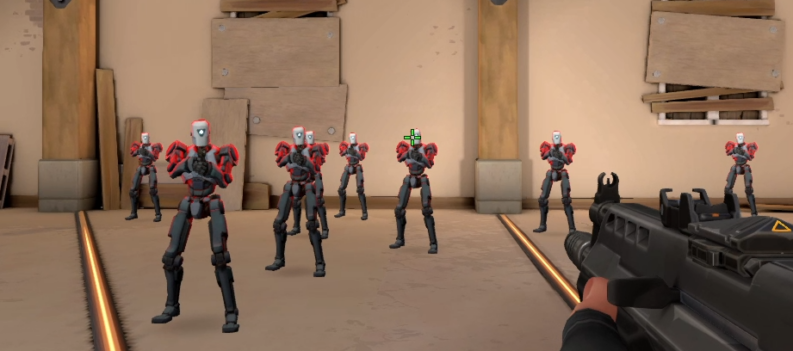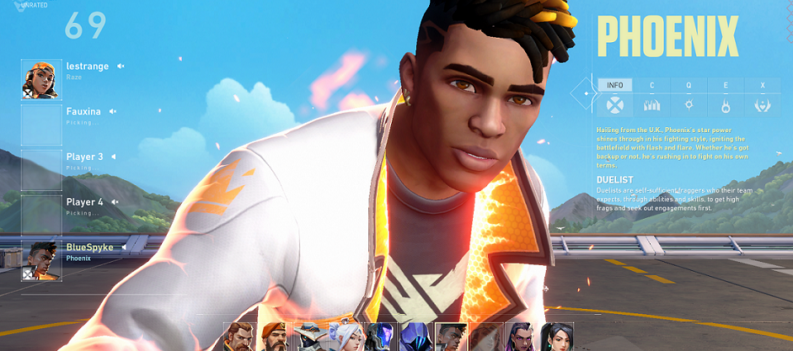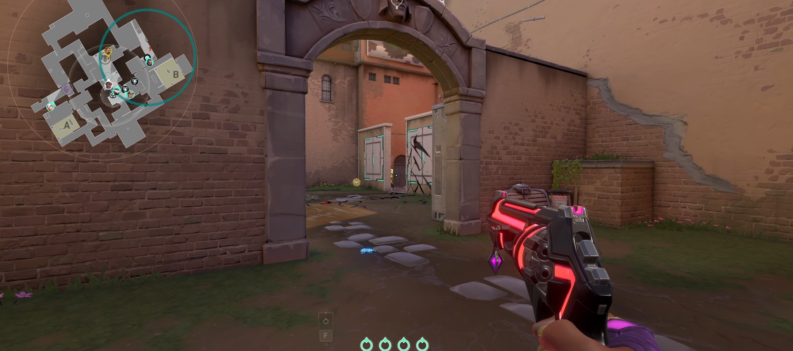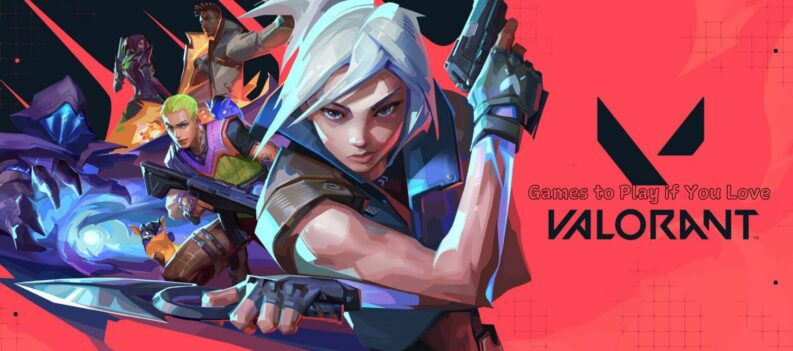Automatic weapons are a dime-a-dozen in FPS games. These are some of the most powerful guns in any tactical shooting game – like CSGO or VALORANT.

CSGO’s most popular automatic rifles are the AK-47 and the M4A1/s. These guns offer varying amounts of ammo per clip and even varying fire rates. The same goes for VALORANT’S Vandal and Phantom.
Since tactical FPS games need players to have pinpoint precision and efficiency, most automatic weapons in these games do not benefit from the ability to unload a whole magazine without stopping. This is because of an important in-game mechanic called recoil.
What Is Recoil?

Recoil is simply the natural knock-back effect of shooting a gun. In tactical shooting games like VALORANT and CSGO, recoil is a mechanic that dictates how inaccurate your shots are relative to how fast you are shooting.
The faster you shoot, the more recoil you will be penalized with. Recoil in FPS games is good because it stops players from mindlessly ‘running and gunning’ in-game and forces players to learn to play with precision, movement, and crosshair placement.
Recoil Reset


In VALORANT, guns have varying recoil reset times; players must wait between firing each shot for maximum accuracy per shot. Game developers often do their best to balance these recoil reset times against the amount of damage a gun deals.

Generally speaking, the more damage a single shot inflicts, the longer the wait time before it becomes accurate again. The inherent wait time balances out the whole gunplay aspect of VALORANT so that no single gun stands out from the rest, and players are forced to use certain weapons only for certain situations.
In a low-time-to-kill game like VALORANT, players must take advantage of the positives of the automatic guns in-game – its continuous and rapid-fire rate while keeping the recoil to a minimum.
History of the Counter-Strafe

In VALORANT, accuracy is tied together with movement. Put, shooting while moving (even slightly) throws off the accuracy of any gun in-game. You have to be standing still when firing your gun. Players are most accurate when their player models are standing still to be the most accurate.
This is where counter-strafing would come in if this were an article about CSGO, but this is VALORANT. Movement is ever so slightly different.
While moving left to right or front to back in CSGO, the player model will not stop immediately after the movement keys are released. Instead, player models go into a short slow-down phase when left alone.
Because of this short slow-down phase, the player is never really accurate until they are at a complete stop. This introduces a natural delay between moving and stopping, affecting the time before players can start shooting accurately once again.
Counter-strafing was the cure. Counter-strafing, as the name suggests, is canceling the natural slowing-down effect of any movement by pressing the opposing movement key. So, if a player was strafing to the right, tapping the left movement key will initiate a leftward movement, which immediately cancels out any other movement briefly. Counter-strafing gives players a small window to shoot at their most accurate.
This is still true in VALORANT, only slightly different.

In VALORANT, releasing the movement keys will also immediately stop any other movement from happening. Players will not have a slow-down phase as they do in CSGO. This also means that players can forgo the act of counter-strafing altogether. By simply releasing the movement keys, players will immediately be accurate.
Methods To Practice Burst-Fire in Valorant
Of course, nobody wants to be an easy target in an FPS game. You must move, running from cover to cover to avoid getting hit. But you still have to shoot as well. Otherwise, you will not seem like a threat to the enemy.
So to become harder to hit but remain accurate while shooting, you must learn how to Counter-Strafe + Burst-Fire in Valorant.
Burst-firing is firing off a quick 2-3 bullets, strafing to the left or right, stopping, and then shooting burst shots again. Rinse and repeat.

Burst-firing is a good learning technique because it helps keep your shots accurate while making yourself harder to hit. In a game where one shot is all it takes to hit the canvass, movement will play an important role in keeping yourself alive and shooting. After all, you are useless to your team if you are dead.
If you are a newer player, this is a technique to master now rather than later because it stops you from developing bad habits such as spraying and praying or crouch spraying. Crouch spraying, in particular, is a bad habit because it makes you an easier target to hit since you will be crouching and not moving while spraying.
To practice Burst-Firing in Valorant, we head on over to The Range:

If you are a newer player, we recommend you check out our Beginner Aim Training Routine For VALORANT, which takes place in The Range. That guide also outlines most of the stuff you need to know about The Range. Read up and incorporate it into your gameplay.
To practice burst firing in The Range, we must first turn on “Movement Error” in our crosshair settings.
- Open the VALORANT Settings menu:

2. Click on the Crosshair Tab:

3. Click on “Primary”:

4. Scroll down to “Inner Lines” on Turn On ” Movement Error.”


This helps us determine when exactly we are most accurate. The movement error option spreads the crosshair gap wider or tighter, depending on your current movement type.



Now that we have Movement Error configured, we can turn on the Practice Bots and move around.


- You can strafe left-stop and right-stop without shooting to get a feel for how fast the crosshair resets to 100% accuracy. Do this for three minutes.
- You can now start shooting targets. To do this properly, you have to strafe left, stop, and fire two bullets, then move on to strafe right, stop and then shoot two bullets. Do this for another 3 minutes.
- Keep doing Step 2 until you get used to the inaccuracy interval between moving and stopping.
Try to keep in mind the following:
- You need to land headshots and headshots only.
- You need to stop. And then shoot.
- You can choose between stopping movement by releasing the movement key or counter-strafe by pressing the opposite directional movement key.
- Take your time. In VALORANT, being accurate means taking your time but landing a precise shot even if you have to tank off some damage. That is what armor is for, anyway.

Now that you are warmed up in The Range let’s move to Deathmatch.
In Deathmatch, we will be restricting ourselves to one-taps only.

You might be thinking, “Why should we be one-tapping only? I thought this was a burst-firing tutorial.”
We know. We know. Just hear us out for a bit.
You already know players are most accurate in VALORANT when standing at a standstill. With that in mind, one-taps are only doable when you are not moving.
When we practice one-taps religiously, we get into the habit of stopping, lining up our shot, and then shooting that single bullet. This carries over well when learning how to burst-fire in Valorant. We can use one-tapping to hit this point home further. We are programming our brains and training our mindsets to take shots only when completely stopped.

One-taps are not easy to do. You must have a perfect symphony of Movement + Crosshair Placement + Click Timing to score one-taps. Believe us when we tell you that you will surprise yourself with some pretty clean kills once you start firing in burst shots. Take note, though, that you will die a lot, and we mean a lot.
Smooth Criminal

Consistent and proper practice is key. Going through the burst firing practice routine without being mindful and present will not yield the same results as a methodical, slowed-down, and intentional practice.
You will most likely die while getting used to this aiming mechanic. A lot. This is normal because, unlike the other players in Deathmatch, you are there to intentionally practice movement and shooting techniques slowly to build the proper muscle memory and mindset. You are not there to spray and crouch and hope you land a shot. Just take your time and line up your crosshair as smoothly as possible. If you practice, the speed will come.















